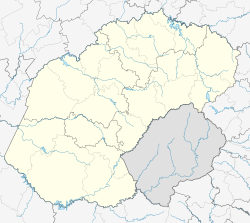Kestell
| Kestell | |
|---|---|
 |
|
|
|
|
| Coordinates: 28°19′S 28°42′E / 28.317°S 28.700°ECoordinates: 28°19′S 28°42′E / 28.317°S 28.700°E | |
| Country | South Africa |
| Province | Free State |
| District | Thabo Mofutsanyane |
| Municipality | Maluti a Phofung |
| Area | |
| • Total | 12.6 km2 (4.9 sq mi) |
| Elevation | 1,700 m (5,600 ft) |
| Population (2011) | |
| • Total | 8,269 |
| • Density | 660/km2 (1,700/sq mi) |
| Racial makeup (2011) | |
| • Black African | 92.8% |
| • Coloured | 0.3% |
| • Indian/Asian | 0.4% |
| • White | 6.4% |
| • Other | 0.1% |
| First languages (2011) | |
| • Sotho | 80.5% |
| • Zulu | 7.5% |
| • Afrikaans | 6.8% |
| • English | 2.5% |
| • Other | 2.6% |
| Postal code (street) | 9860 |
| PO box | 9860 |
| Area code | 058 |
Kestell is a small maize farming town in the Free State province of South Africa.
Town 46 km west of Harrismith and 45 kilometres (28 mi) east of Bethlehem. The new village was laid out in 1905 on the farms Mooifontein and Driekuil, acquired from Adriaan and Johannes Bezuidenhout. It became a municipality in 1906.
It is named after the Reverend Dr. (1854 - 1941), minister of the Dutch Reformed Church from 1894 to 1903, author and cultural leader, who played an important role in the Anglo-Boer War and later helped with the Afrikaans Bible translation. The local NG Church building, designed by famed architect of dozens of churches and the Voortrekker Monument, Gerard Moerdijk, was inaugurated on 31 March 1928.
It is located 20 kilometres (12 mi) southeast from the Battle of Groenkop-site of the Second Boer War. The battle took place on 25 December 1901 when General Christiaan De Wet's Boer troops defeated a British column.
...
Wikipedia



